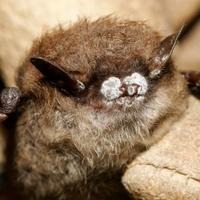Bats have earned the distinction among animal enthusiasts as being the only true flying mammals and the second largest group of mammals. These cave dwellers are nocturnal which means their favourite time to hunt for food is nighttime.
Bats are not usually on many people’s favourite lists, but like many other creatures, they do serve a critical purpose to the ecosystem. They keep the bug population in check by feasting on them, and their droppings are highly nutritious for the soil, which is why many fertilizer producers are now infusing it in their products. In the wild, they help to keep greenery alive by dispersing seeds that later germinate into plants.
White nose gets its name from the bats physical appearance when diagnosed with White Nose Syndrome.The Immediate Threat
White-nose syndrome is so named because the ailment causes a white fungus to appear on the snouts of its victims. This disease was first noticed among bats in a cave in North-Eastern America in 2007. The first Canadian case of White Nose Syndrome was discovered in 2010 when Ontario’s Ministry of Natural Resources confirmed the diagnosis in a test subject.
The Symptoms
Bats that are infected by the disease tend to leave their hibernation sites at odd times. This means you will see them flying around in the day and very early in the spring. They may appear to have trouble flying or may be on the ground, barely moving. Infected bats may also be rabid which heightens the need for extra caution in dealing with them.
Luckily for human beings, there have been no reported cases of human infection, but for the bat population, a terrifying state of doom is looming. If the disease is not put under control, the world could lose entire species of these flying rodents.
Who’s on the Ground?
Animal control organizations such as the Canadian Cooperative Wildlife Health Center and Bat Conservation International, are working hard to alleviate the situation. They are coordinating efforts to identify the spread of the illness as well as decontaminate areas of infection. Private Durham animal control teams are working in tandem with the organizations.
But saving the world’s wildlife bat species is a job for everyone, not just the related authorities and agencies.
White nose comes from bats who typically live in caves.How Can You Help?
Report any suspicion you may have of infection in your area. If you spot one or more bat carcasses, do not touch them. Instead, contact the authorities (the Canadian Cooperative Wildlife Health center should be your first line of contact) or the Durham animal control specialists like those at Skedaddle. If you must move a bat, ensure that it is dead first and use a tool that keeps a safe distance between you and the creature’s carcass. The best option is a shovel (which you must then sanitize).
Even though transmission to humans has not yet been detected, you don’t want to put yourself and your family at any unnecessary risk. Instead, have Skedaddle’s team of expert humane wildlife animal technicians handle all your bat infestation cases. Our team is trained to remove wild animals and reduce or eliminate the associated bacterial contamination risk. Safeguard your home with Skedaddle’s protective services to keep bats and other wildlife creatures out of your home.



